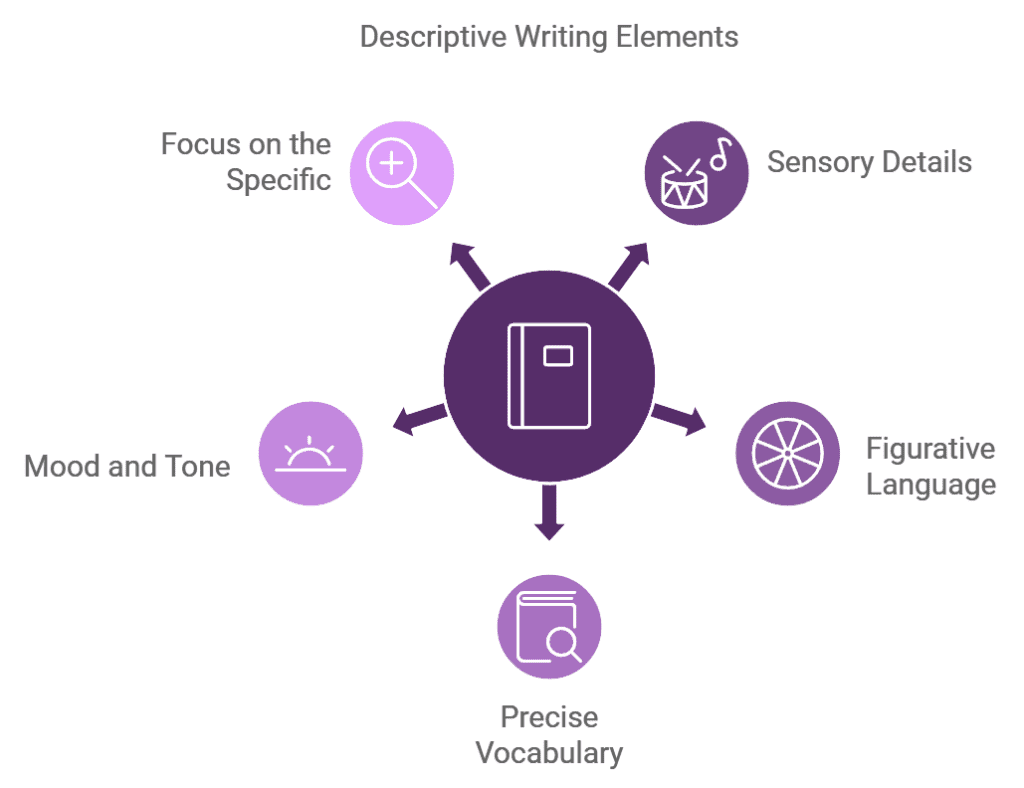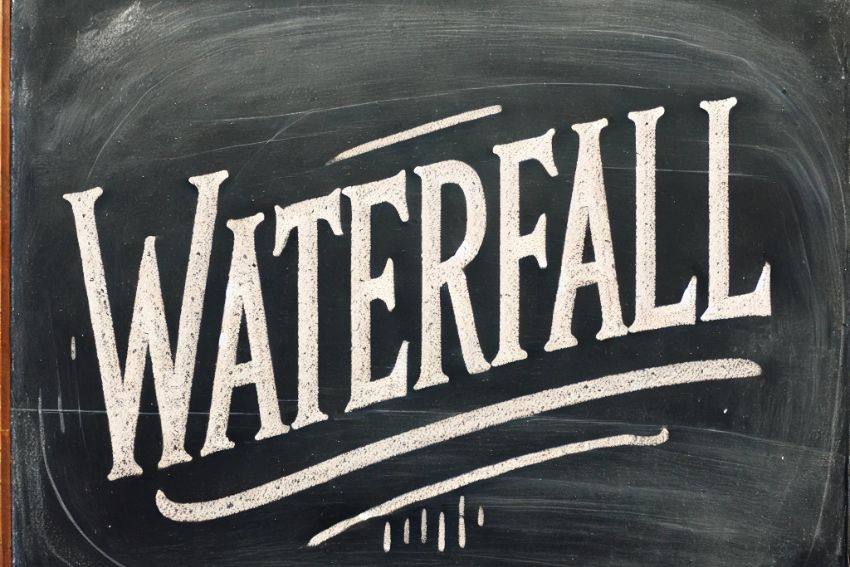What Is Descriptive Writing? – Essential Guide For You
Descriptive writing is a fundamental skill that brings language to life, allowing writers to paint vivid pictures in readers’ minds through words. While narrative, persuasive, and expository writing focus on storytelling, argumentation, and explanation, descriptive writing hones in on the details, setting a scene or mood that captivates the audience.
For students, mastering descriptive writing is particularly valuable, as it sharpens their observation and expression skills, critical for both GCSE and A-Level exams where creativity and precision are rewarded. In this comprehensive guide, we aim to walk students through the art of descriptive writing, providing practical tips and examples to enhance their skills and improve their performance. Let’s start!
What is Descriptive Writing?
Descriptive writing uses detailed observation and sensory language to describe people, places, objects, or scenes in a way that evokes an emotional response from the reader. This type of writing goes beyond merely listing details; it involves selecting specific, vivid words to convey mood, setting, and atmosphere, making the scene almost tangible for the reader. Rather than simply informing or persuading, descriptive writing immerses the reader in an experience, focusing on creating a strong visual, auditory, or emotional image.

What Are The 5 Key Parts of Descriptive Writing?
Sensory Details
Sensory details involve using language that appeals to the five senses: sight, sound, smell, taste, and touch. These details help readers to experience the scene as if they were there themselves.
- Example: “The warm, golden sand slipped between my toes, and the salty ocean breeze tickled my nose as the gentle crash of waves filled the air. Seagulls called out overhead, and I could taste the faint saltiness lingering on my lips.”
- Effect: Sensory details immerse the reader fully, making the scene vivid and engaging. They allow readers to see, hear, feel, taste, and smell the surroundings, enriching the experience.
Figurative Language
Figurative language includes similes, metaphors, personification, and hyperbole, which add layers of meaning and creativity to descriptions.
- Example: “The storm clouds were angry giants, rolling across the sky with booming voices. Lightning danced like wild sparks from a fire, illuminating the darkened landscape.”
- Effect: Figurative language makes descriptions more imaginative and impactful. By comparing elements in unique ways, writers add depth and create more powerful imagery.
Precise Vocabulary
Using specific, vivid words over vague or general terms helps create a clearer, sharper image in the reader’s mind. Precise vocabulary focuses on exact word choice to make descriptions more effective.
- Example: “The old mansion stood desolate on the hill, its crumbling facade revealing dark, gaping windows like hollow eyes, and the ivy creeping up its walls gave it an eerie, lifeless look.”
- Effect: Precise vocabulary creates a strong, detailed image without unnecessary words, allowing readers to visualise the scene with clarity. It brings accuracy and richness to the description.
Mood and Tone
Mood is the atmosphere of the writing, while tone reflects the writer’s attitude. These elements set the emotional backdrop of the description, helping readers to feel a specific way about the scene.
- Example: “The narrow alley was shrouded in darkness, the faint flicker of a broken streetlamp casting distorted shadows on the damp brick walls. A feeling of unease hung thick in the air, and every step echoed ominously in the silence.”
- Effect: Mood and tone evoke an emotional response, guiding the reader’s perception of the scene. Whether it’s a sense of warmth, suspense, or fear, mood and tone help shape the reader’s experience and reaction.
Focus on the Specific
Rather than describing everything, focusing on specific details highlights particular aspects, adding depth and character to the description. This specificity makes descriptions memorable and realistic.
- Example: “She wore a delicate silver bracelet that clinked softly with every movement, the tiny charms shaped like stars catching the light as she spoke. Each charm was intricately engraved, showing signs of wear from years of touching and turning them between her fingers.”
- Effect: Focusing on specific details brings out unique characteristics and personal elements in a description. It allows the reader to feel a deeper connection to the scene or object, making it feel more authentic and personal.
By integrating these five key parts, descriptive writing becomes richer, more vivid, and emotionally resonant, allowing readers to step directly into the writer’s scene or experience.
How To Make Your Descriptive Writing Effective?
Effective descriptive writing brings a scene, character, or object to life in the reader’s mind, using rich detail and engaging language to make the experience feel immersive and tangible. To achieve this, descriptive writing relies on several key elements, each adding depth and clarity to the narrative. Here’s what makes descriptive writing powerful and impactful:
Vivid Details
Vivid details involve specific, sensory-rich descriptions that appeal to the reader’s senses. Rather than simply saying “The garden was beautiful,” effective descriptive writing would zoom in on the specific qualities that make it beautiful: the colors, sounds, textures, and scents.
- Example: “Bright marigolds and red tulips lined the path, their petals glowing in the sunlight, while the earthy smell of freshly turned soil mingled with the soft rustle of leaves in the gentle breeze.”
- Effect: Vivid details make the scene feel immediate and real, helping readers experience the place or moment as if they were there. This detail makes the writing more engaging and leaves a lasting impression.
Figurative Language
Figurative language, including similes, metaphors, and personification, adds layers of meaning and creativity. It helps convey emotions, comparisons, or abstract ideas in ways that are both imaginative and relatable.
- Example: “The clouds were fluffy pillows drifting lazily across the sky, and the sun dipped below the horizon like a gold coin sinking into a pond.”
- Effect: Figurative language enhances descriptions by painting pictures with words, allowing readers to see familiar things in new ways. It adds richness and depth, making the writing more dynamic and emotionally evocative.
Precise Language
Precise language means choosing words carefully to ensure that each word adds to the reader’s understanding of the scene. Instead of vague or general terms, precise language uses specific vocabulary that captures exactly what the writer intends.
- Example: “The car wasn’t just old; it was dilapidated, its rusted metal frame held together by patches of mismatched paint, and the interior smelled of stale cigarettes and cracked leather.”
- Effect: Precise language makes descriptions sharper and clearer. By using words that carry specific meanings, writers can create a stronger, more accurate image in the reader’s mind, leaving no room for misinterpretation.
Thoughtful Organization
Effective descriptive writing has a logical flow, guiding readers through the scene in a way that feels natural. Writers might start with a broad view and then zoom in on details, or they might describe things in the order they are experienced.
- Example: In describing a beach, a writer could begin with the vastness of the ocean, move to the shoreline with footprints in the sand, and finally focus on a single shell gleaming in the sunlight.
- Effect: Thoughtful organization ensures that readers are not overwhelmed by details but are instead guided through the scene in a way that feels engaging and purposeful. It keeps the writing clear and makes the description easier to follow and more impactful.
Use of Language Features
Creates rhythm and draws attention to key phrases. Example: “The gentle giant groveled in the green grass.”
- Onomatopoeia: Adds realism by mimicking sounds, making descriptions more immersive. Example: “The leaves crunched beneath her feet.”
- Imagery: Uses language to create mental pictures, appealing to the senses. Example: “The ice was a blanket of silver, stretching endlessly under the pale winter sky.”
- Effect: Language features like these add texture and musicality to descriptive writing. They make writing more memorable, engaging, and appealing by creating layers of sound, rhythm, and visual impact that resonate with readers.

What Effective Descriptive Writing Looks Like
In effective descriptive writing, each element contributes to the overall impact of the piece. Vivid details bring the scene to life, figurative language adds depth and emotion, precise language sharpens the image, and thoughtful organization guides the reader naturally. Language features such as alliteration, onomatopoeia, and imagery further enrich the description, turning writing into an experience rather than just a narrative.
By combining these elements, descriptive writing becomes a powerful tool for storytelling, evoking emotions and transporting readers to another time, place, or state of mind. If you want your writing to be effective this comprehensive approach will enable you to leave a strong, lasting impression on readers, making the writing truly memorable.
Why Learning Descriptive Writing Is Important?
Learning descriptive writing is incredibly valuable for students because it enhances their ability to communicate vividly and effectively. Descriptive writing isn’t just about making prose “sound nice”; it develops key skills that extend beyond English class and influence overall academic performance, creativity, and emotional intelligence. Here’s how it helps students:
Improves Observation Skills
Descriptive writing encourages students to pay attention to details in their surroundings and experiences, enhancing their ability to observe and appreciate the world around them. This skill sharpens their perception and helps them see subtleties in everyday life, which can make them more insightful readers, writers, and thinkers.
Strengthens Vocabulary and Language Mastery
To describe scenes and emotions effectively, students must expand their vocabulary and use precise language. Learning to use sensory language, figurative speech, and specific words helps students express ideas clearly and imaginatively, ultimately improving both their written and spoken communication.
Encourages Creativity and Imagination
Descriptive writing pushes students to think creatively, as they learn to show rather than tell. This creativity is important not only in English but also in other subjects where unique thinking and perspective are valuable, such as art, drama, and even sciences where innovative thinking is encouraged.
Develops Empathy and Emotional Awareness
By describing characters, places, or experiences from various perspectives, students learn to put themselves in others’ shoes. This process fosters empathy, as students consider how different sensory details and emotions affect individuals differently. Descriptive writing also helps students to process and express their own emotions, building emotional intelligence.
Prepares for Exams and Real-World Writing
Descriptive writing is often a significant component of exams like GCSE and A-Level English, where students are assessed on their ability to craft engaging narratives or describe scenes vividly. Mastering descriptive writing techniques can boost their grades. Furthermore, the skills they acquire are useful for other real-world tasks, from writing reports and essays to crafting compelling narratives in journalism or creative fields.
Enhances Analytical and Critical Thinking
To write descriptively, students must carefully choose words, phrases, and details that convey the right mood or message. This process requires critical thinking and analysis, as they consider how each choice shapes the reader’s experience. These analytical skills are essential in all academic disciplines and in life beyond school.
Builds Confidence in Self-Expression
Being able to describe scenes, emotions, and ideas confidently helps students feel more capable as writers and communicators. They learn to trust their own voice and convey their experiences, thoughts, and perspectives with clarity, which is empowering and builds self-assurance in their writing abilities.
By teaching descriptive writing, educators equip students with tools that benefit both their academic and personal growth, turning them into more observant, thoughtful, and expressive individuals.

Effective Tips To Learn Descriptive Writing
Every parent who wants to help their children in learning process, should know that descriptive writing effectively involves encouraging students to focus on sensory details, precise language, and creative techniques that make their writing vivid and engaging. Here are some tried-and-true methods to help children excel in descriptive writing, along with tips and resources:
Start with Sensory Exploration
- Encourage children to use all five senses—sight, sound, taste, touch, and smell—when describing a scene or object. This approach helps them go beyond visual descriptions and create a full sensory experience for the reader.
- Bring objects to them (like flowers, fruits, or textured materials) and have children describe each using all senses. Alternatively, use images, videos, or soundscapes for sensory prompts.
- Resource: Sensory Writing Prompts
Use Descriptive Writing Graphic Organizers
- Provide graphic organizers to help children plan their descriptions. Organizers like sensory charts or five-paragraph structures can help students organzse thoughts and focus on details before writing.
- Have them fill in a graphic organizer that breaks down descriptive details by sense, character, setting, or object.
- Resource: Use Free Graphic Organizers to achieve your goal effectively.
Introduce Figurative Language with Examples
- Teach children figurative language techniques (like similes, metaphors, and personification) through examples in literature. Discuss how these devices enhance descriptions.
- Use excerpts from literature that employ figurative language, such as The Great Gatsby for similes or To Kill a Mockingbird for metaphors. Have students identify and create their own examples.
- Resource: ReadWriteThink’s Figurative Language
Incorporate Word Choice Activities
- Show the impact of precise vocabulary by encouraging children to replace vague words with more specific, descriptive ones.
- Create a “word swap” exercise where they replace generic words with vivid alternatives (e.g., “walked” could become “strolled” or “sauntered”).
- Resource: Vocabulary.com to help students find richer vocabulary alternatives and explore nuances of word meanings.
Use Mentor Texts for Inspiration
- Mentor texts provide models of effective descriptive writing, showing them how skilled writers use details, structure, and tone.
- Choose short passages from books that are rich in description (e.g., Charlotte’s Web for younger students, The Book Thief for older ones). Discuss how the author’s word choice, figurative language, and sensory details create vivid images.
- Resource: Mentor Text Lists on We Are Teachers, offering curated texts for different grade levels and types of writing.
Encourage Free Writing and Show, Don’t Tell
- To help Children practice descriptive techniques, assign free writing sessions focused on showing rather than telling. Encourage them to “paint” with words.
- Give them a simple prompt, like “a rainy day,” and ask them to describe it without using words like “rain” or “wet.” This forces them to get creative and descriptive.
- Resource: Use Show, Don’t Tell worksheets for better results.
Explore Digital Tools for Interactive Learning
- Incorporate digital platforms that offer descriptive writing exercises, prompts, and feedback.
- Use platforms like NoRedInk for interactive grammar and descriptive language exercises, or Storybird for image-based storytelling that can inspire detailed descriptions.
- Resource: NoRedInk and Storybird both offer free resources, with engaging tools for language development and creativity.
Additional Online Sources for Descriptive Writing Practice
- BBC Bitesize (GCSE) – Offers resources tailored to GCSE students with examples, interactive quizzes, and practice exercises for descriptive writing.
- The Purdue OWL – Great for students looking to refine their writing skills, with resources on descriptive writing and language. Purdue OWL Writing Lab
These resources and techniques can support students in developing their descriptive writing skills, making their prose vivid, engaging, and powerful. With practice, feedback, and examples, they’ll learn to express scenes, emotions, and details in ways that captivate readers.
Conclusion
In conclusion, mastering descriptive writing equips students with essential skills that enhance their ability to observe, express, and connect with their audience. This skill not only benefits them in exams like GCSE and A-Levels but also develops creativity, empathy, and critical thinking, all of which are invaluable beyond the classroom.
For those looking to strengthen their descriptive writing, our English Language Online Tutors can provide personalized guidance, helping students refine their language, use vivid details, and confidently bring their writing to life. Seeking support from experienced tutors can be the key to transforming writing skills and achieving success. We hope our guide was helpful and by exploring it you’ll improve your writing skills. Good Luck!
Here Are Other Topics You May Be Interested In
Mastering GCSE English Writing: Essential Skills for Exam Success
GCSE English Grammar and Punctuation: A Comprehensive Guide
GCSE English Language – Everything You Need to Know
Creative Writing: Everything You Need to Know








